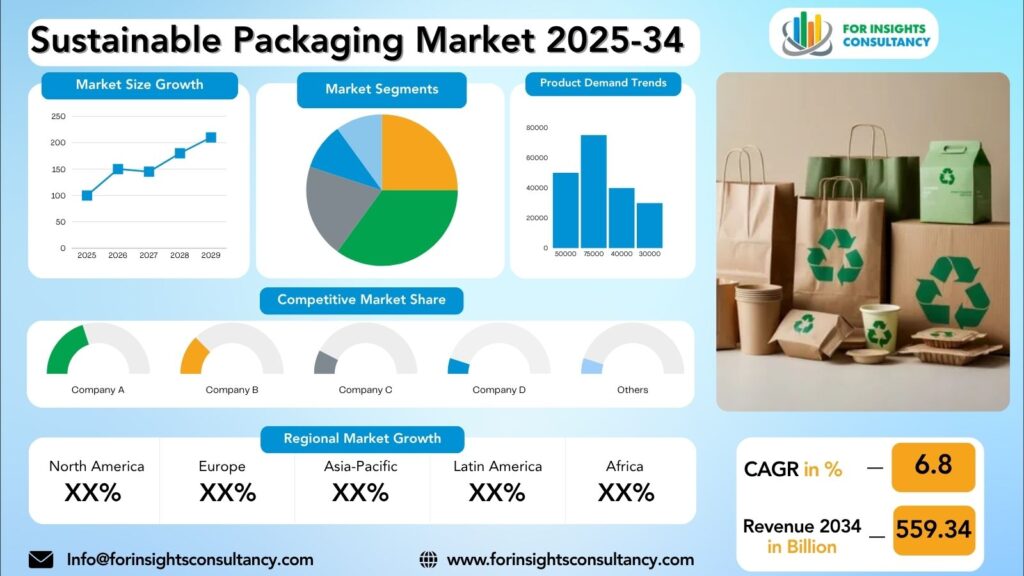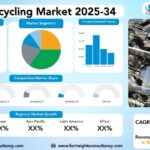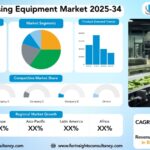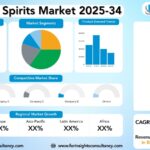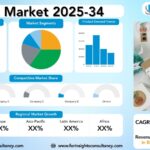
Sustainable Packaging Market Size, Trends Analysis Research Report By Material (Paper & Paperboard, Plastic, Glass, Metal), by Process/Type (Recyclable, Reusable, Biodegradable / Degradable), by Packaging Type, by Application/End-use Industry,and By Region Global Market Analysis And Forecast, 2025-2034
Oct-2025 Formats | PDF | Category: Packaging | Delivery: 24 to 72 Hours
The report highlights that the market outlook is significantly influenced by swift shifts in global trade relations and tariffs. It emphasizes the necessity of updating the report before delivery to incorporate the most current status, which includes revised market forecasts and a comprehensive analysis of the quantified impacts of these changes.
Sustainable Packaging Market Is Forecast to Increase from USD 318.6 Billion In 2025 To USD 559.34 Billion By 2034, At A CAGR Of 6.8%.
Sustainable Packaging Market: A Comprehensive Overview and Future Developments
The sustainable packaging market is experiencing considerable growth, driven by heightened awareness of environmental issues and a transition towards eco-friendly practices. Companies are increasingly adopting sustainable packaging solutions as a means to diminish their carbon footprint while catering to consumer demand for environmentally responsible products. Future developments in this market are projected to emphasize innovation and technological advancements aimed at enhancing the sustainability of packaging materials. This includes the creation of biodegradable packaging, exploration of alternative materials like plant-based plastics, and enhancement of recycling systems. As consumer awareness of the environmental implications of packaging grows, businesses are likely to persist in their investments in sustainable packaging solutions to align with these changing market expectations.
Market Insights
- Asia Pacific region is frequently reported to hold the largest revenue share in the sustainable packaging market for 2024, with some sources also pointing to Europe and North America as leaders.
- Europe or Asia-Pacific (APAC) as the market leader or the fastest growing. Data varies, but APAC is frequently cited as the fastest-growing region with a high Compound Annual Growth Rate (CAGR), often around 7.5% to over 8% during the forecast period (e.g., 2025-2034).
- The percentage of the U.S. population residing in urban areas in 2024 is 83.54%.
- Concerning market segmentation, the Food & Beverages sector consistently accounts for the largest revenue share by application, often exceeding 38% the total market, owing to the high demand for eco-friendly packaging in consumer goods.
AI Impact
The Sustainable Packaging Market is currently undergoing a transformative phase, significantly influenced by advancements in artificial intelligence (AI). Technologies such as machine learning and data analytics are being employed to enhance various aspects of packaging, including the optimization of design processes, reduction of material waste, and improvements in supply chain efficiency. AI algorithms are particularly effective in helping companies to analyze consumer preferences and behaviors, leading to the development of more personalized and environmentally sustainable packaging solutions. This application of AI not only supports the sustainability initiatives of businesses but also aids in cost reduction and helps companies adapt to the increasing demand for eco-friendly packaging options. In essence, AI is reshaping the sustainable packaging sector by driving innovation, refining operational processes, and empowering companies to make informed decisions that contribute positively to environmental sustainability and their overall financial performance.
Market Dynamics
Trends
Trends in the sustainable packaging market are significantly shifting towards biodegradable and compostable materials as a way to diminish environmental impact. A notable increase in consumer demand for packaging that not only minimizes waste but is also sourced from renewable resources reflects a growing eco-consciousness. The market sees a rise in packaging designs that emphasize recyclability and reusability, resonating well with environmentally aware consumers. Furthermore, companies are actively investigating innovative alternatives such as plant-based plastics and packaging sourced from agricultural by-products. The landscape is also being transformed by technological advancements, which facilitate the creation of packaging materials that satisfy both sustainability and functionality, catering to the needs of consumers and businesses aiming to lower their carbon footprint.
Growth Drivers
The Sustainable Packaging Market is experiencing substantial growth, propelled by several significant factors. One of the primary drivers is the rising consumer awareness and demand for eco-friendly products, which has compelled companies to implement sustainable packaging solutions aimed at minimizing their carbon footprint. Additionally, the enforcement of stringent government regulations designed to diminish plastic waste and encourage the use of recyclable materials has further catalyzed this transition towards sustainable packaging. Technological advancements have also played a crucial role, rendering sustainable packaging more cost-effective and efficient, thereby enhancing market growth. Furthermore, businesses are increasingly acknowledging the long-term advantages of adopting sustainable packaging, including improved brand reputation and strengthened customer loyalty, which motivate them to invest in these eco-friendly solutions. Collectively, these factors are projected to sustain and accelerate the growth trajectory of the Sustainable Packaging Market in the years ahead.
Restraints
In the sustainable packaging market, several key restraints are hindering growth and adoption. Firstly, the initial cost of eco-friendly materials tends to be significantly higher than that of traditional packaging solutions, which can discourage businesses from transitioning. Furthermore, there is limited availability of recycled materials, complicating the production of sustainable packaging and potentially increasing costs. Companies also face difficulties in ensuring that sustainable packaging provides the same level of durability and protection for products, which is paramount for consumer confidence and satisfaction.
Another major barrier is the absence of standardized regulations and certification processes regarding sustainable packaging. This lack of clear guidelines can create confusion among consumers regarding what qualifies as sustainable, ultimately impacting purchasing decisions. Additionally, the complexity involved in the supply chains and logistics necessary for sourcing, manufacturing, and recycling sustainable packaging materials adds another layer of challenge for companies attempting to adopt greener practices.
Despite an increasing consumer demand for sustainable packaging, these restraints must be effectively addressed to foster further growth and wider acceptance in the market. By overcoming these obstacles, companies can advance towards more environmentally friendly options, thus contributing to sustainability goals while meeting market needs.
Opportunities
The sustainable packaging market is currently witnessing significant growth opportunities due to a collective emphasis on environmental conservation from both businesses and consumers. Companies are encouraged to invest in innovative packaging solutions that focus on reducing waste, promoting recycling, and decreasing carbon emissions. The utilization of eco-friendly materials, including biodegradable plastics, recyclable paper, and compostable packaging, allows businesses to respond to the rising consumer demand for sustainability while also distinguishing themselves in a competitive landscape. Furthermore, an increased awareness of climate change and plastic pollution is driving regulatory changes that support sustainable packaging practices, thereby creating a favorable business environment for companies that adopt green strategies. This shift towards sustainable packaging not only provides businesses with opportunities to enhance their brand image and attract environmentally conscious consumers but also contributes to the overall well-being of the planet.
Challenges
The sustainable packaging market is currently confronted with several significant challenges that impede its growth and wider adoption. A primary issue is the necessity to balance sustainability with cost-effectiveness; many sustainable materials and technologies tend to be more expensive than traditional packaging options. This economic factor makes it difficult for businesses to rationalize the shift toward sustainable solutions. In addition to cost considerations, there is a pressing need for enhanced consumer education and awareness surrounding sustainable packaging. A considerable number of consumers remain uninformed about the benefits of sustainable options or how to recycle and dispose of them correctly, which can stifle demand for these solutions.
Furthermore, the absence of standardized regulations and certifications for sustainable packaging contributes to market confusion, complicating the decision-making process for businesses aiming to adopt sustainable practices. Overall, effectively addressing these multifaceted challenges is of paramount importance to ensure the sustainable packaging market not only continues to grow but also plays a significant role in promoting environmental conservation and sustainability.
Sustainable Packaging Market Top Companies Covered In This Report:
Evaluate The Strategic Positioning And Innovation Pipelines Of Leading Market Companies-From Multinational Enterprises To Disruptive Regional Firms. Understand How Key Players Are Innovating, Expanding, And Capturing Value, And Use Competitive Benchmarks To Plan Your Next Move.
- Tetra Pak
- Elevate Packaging
- Huhtamaki Oyj
- Mondi
- Amcor plc
- Sealed Air
- Sonoco Products Company
- Smurfit Kappa
- Berry Global Inc
- DS Smith
- Atlantic Packaging
- UFlex Limited
- Constantia Flexibles
- Genpak
- Reynolds Packaging
- Crown Holdings, Inc.
- Gerresheimer AG
- Novamont S.p.A.
- WestRock Company
- Ernest Packaging Solutions
- NEFAB GROUP
- Scholle IPN
- Farnell Packaging
- Greiner Packaging
- Greendot Biopak
Sustainable Packaging Market Company News 2024 and 2025
Tetra Pak
Won the Resource Efficiency award at the Sustainable Packaging News Awards 2024 for its aseptic carton package with a paper-based barrier. This innovation increases the paperboard content from an average of 70% to approximately 80%, aiming to reduce the carbon footprint by up to one-third.
Huhtamaki Oyj
Launched new home and industrial compostable and recyclable ice cream cups (Jul 2025). Announced an innovative packaging solution, ‘ProDairy’, which reduces plastic content to below 10% for yogurt and dairy products while maintaining recyclability (Feb 2025). Maintained its MSCI sustainability score of ‘A’ (Dec 2024).
Mondi
Showcased numerous sustainable innovations at FACHPACK 2024 and FACHPACK 2025. Highlights include the recyclable FlexiBag Reinforced (a PE-based mono-material) and the re/cycle Protective Mailer (a fully paper-based padded mailer for e-commerce) (2024-2025). Continues to focus on its broad range of FunctionalBarrier Paper for various end markets.
Amcor plc
Released its 2024 Sustainability Report, highlighting key achievements and progress towards its sustainability goals. Announced its combination with Berry Global is on track for closing in Q1 2025, which aims to create a truly international sustainable packaging solutions leader.
Segmented View of The Industry:
The Sustainable Packaging Market Is Mapped Through A Multidimensional Lens-Tracking Shifts Across Product Type, Applications, And Geographic Regions. This Segmented Approach Enables Businesses to Localize Their Growth Plans And Align Offerings With The Most Profitable Demand Centres.
Segmentation By Material
- Paper & Paperboard
- Plastic
- Glass
- Metal
Segmentation ByProcess/Type
- Recyclable
- Reusable
- Biodegradable / Degradable
Segmentation ByPackaging Type/Format
- Primary Packaging
- Secondary Packaging
- Tertiary Packaging
- Rigid Packaging
- Flexible Packaging
Segmentation by Application/End-use Industry
- Food & Beverages
- Personal Care & Cosmetics
- Healthcare / Pharmaceuticals
- E-commerce & Retail
- Consumer Goods
- Others
Global Geographic Coverage:
The Report Provides In-Depth Qualitative And Quantitative Data On The Sustainable Packaging Market For All Of The Regions And Countries Listed Below:
North America
The sustainable packaging market in North America is witnessing significant growth, primarily fueled by heightened consumer awareness of environmental issues and supportive government initiatives. The region is projected to experience a GDP growth rate of approximately 2.3%, coupled with an inflation rate of around 1.8%. In the United States, one key factor contributing to this growth is a government subsidy aimed at encouraging eco-friendly packaging solutions. This financial support has spurred businesses to transition towards sustainable packaging practices, resulting in a notable increase in demand for such products.
E-commerce platforms currently serve as the leading channel for sustainable packaging distribution, while grocery stores and supermarkets represent the fastest-growing segment in this market. In North America, consumers are increasingly placing a high value on sustainability and ethical sourcing when making purchasing decisions, effectively making these considerations essential criteria for many buyers. In contrast, emerging markets tend to prioritize affordability and brand recognition, reflecting different consumer priorities where price and status often outweigh sustainability concerns.
Overall, the sustainable packaging market in North America is well-positioned for ongoing expansion, driven by changing consumer preferences that favor environmentally responsible products and the supportive regulatory environment that promotes such practices.
Europe
The Sustainable Packaging Market in Europe is witnessing notable growth, with a projected GDP growth rate of 3.5% and an inflation rate of 1.8%. Germany leads this market due to a government subsidy that encourages eco-friendly practices, substantially increasing the demand for sustainable packaging solutions in the country. This development sets a benchmark for other European nations. The primary sales channel for sustainable packaging is online retail, providing consumers with easy access to eco-friendly products. However, the most rapidly expanding channel is direct-to-consumer sales, indicating a shift towards personalized and sustainable shopping experiences. Across Europe, consumers are increasingly prioritizing sustainability, ethical sourcing, and localism in their purchasing decisions, which are now essential criteria for conscientious buyers. In contrast, consumers in emerging markets often prioritize price and status over sustainability, making eco-friendly packaging a less critical factor in their purchasing behavior.
Asia Pacific
The Sustainable Packaging Market in the Asia Pacific region is poised for substantial growth, driven by a rising focus on environmental sustainability. The region is experiencing a projected GDP growth of 5% alongside an inflation rate of 2%, with countries such as India, Indonesia, and Vietnam at the forefront of adopting eco-friendly packaging solutions. In India, a significant catalyst for this shift has been the government’s ban on single-use plastics, which has prompted an increased demand for biodegradable packaging materials. E-commerce platforms serve as the primary channel for sustainable packaging in India, while specialty retail stores that appeal to eco-conscious consumers represent the fastest-growing segment.
In contrast, consumer behavior in emerging markets like Indonesia reveals a tendency to prioritize price over sustainability, which significantly impacts purchasing choices. Nevertheless, in more developed markets such as Japan and South Korea, there is a notable trend towards ethical sourcing and localism, with eco-friendly packaging increasingly regarded as an essential requirement for consumers. This duality highlights the varying priorities and adoption rates of sustainable packaging solutions across different countries in the Asia Pacific region, reflecting a significant transformation in consumer and regulatory landscapes as the push for sustainability gains momentum.
Middle East and Africa
The Sustainable Packaging Market in the Middle East and Africa is poised for substantial growth, underpinned by a projected GDP increase of 4.1% and an inflation rate of 3.5% for the region. A key factor in Egypt driving the adoption of sustainable packaging is the government’s Green Economy Strategy, which actively supports businesses through subsidies for implementing environmentally-friendly practices. The primary distribution channel for sustainable packaging within the region is e-commerce, while hypermarkets are emerging as the fastest-growing avenue, propelled by a rise in consumer awareness and demand for sustainable options. Consumers across the Middle East and Africa exhibit a strong preference for sustainability and ethical sourcing in packaging, viewing these qualities as essential. Nonetheless, in certain developing markets, there is a noticeable emphasis on balancing cost-effectiveness with sustainability, as price and prestige remain important considerations for many consumers.
Reasons To Buy:
- The Research Would Help Top Administration/Policymakers/Professionals/Product Advancements/Sales Managers And Stakeholders In This Market In The Following Ways.
- The Report Provides Sustainable Packaging Market Revenues At The Worldwide, Regional, And Country Levels With A Complete Analysis To 2034 Permitting Companies To Analyze Their Market Share And Analyze Projections, And Find New Markets To Aim For.
- To Understand The Most Affecting Driving And Restraining Forces In The Market And Their Impact On The Global Market.
- Major Changes And Assessment In Market Dynamics And Developments.
- The Objective Of The Sustainable Packaging Market Report Is To Identify New Business Opportunities Using Quantitative Market Forecasts.
- Formulate Sales And Marketing Strategies By Gaining An Understanding Of Competitors, Their Positioning, And Strengths & Weaknesses.
Faq – What Global Leaders Are Asking
What Is The Growth Prospect For The Sustainable Packaging Market By 2034?
Sustainable Packaging Market Is Expected To Achieve A Stable Growth Rate With A Compound Annual Growth Rate (CAGR) Of About 6.8% From 2025 Through 2034.
What Is Driving The Growth Of The Sustainable Packaging Market?
The market growth is primarily driven by increasing consumer environmental awareness, stringent government regulations, and corporate sustainability goals.
This escalating threat landscape is compounded by accelerated digital transformation (cloud migration, remote work) and stringent global regulatory compliance.
Who Are The Key Players In The Sustainable Packaging Market, And What Are Their Market Shares?
The Sustainable Packaging Market Includes Major Companies Tetra Pak, Elevate Packaging, Huhtamaki Oyj, Mondi, Amcor plc, Sealed Air, Sonoco Products Company, Smurfit Kappa, Berry Global Inc, DS Smith, Atlantic Packaging, Others.
Specific Market Share Data Is Not Publicly Available And Is Typically Provided In Detailed, Proprietary Market Research Reports.
Which Regions Are Leading The Sustainable Packaging Market Growth?
Europe holds the largest market share, while the Asia-Pacific region is projected to be the fastest-growing market.
Customized Report as per your Business Needs
- Our analysts will work directly with you and understand your needs
- Get data on specified regions or segments, competitor and Vendors
- Data will be formatted and presented as per your requirements
Any Requirement Contact Us: Https://Www.Forinsightsconsultancy.Com/Contact-Us/
Table of Contents
For TOC Contact us: https://forinsightsconsultancy.com/contact-us/

